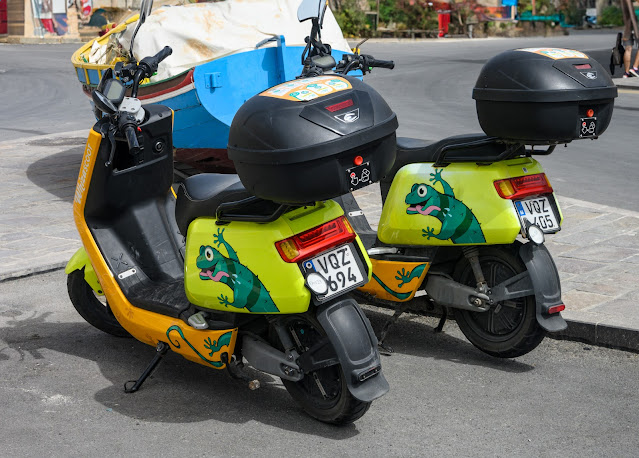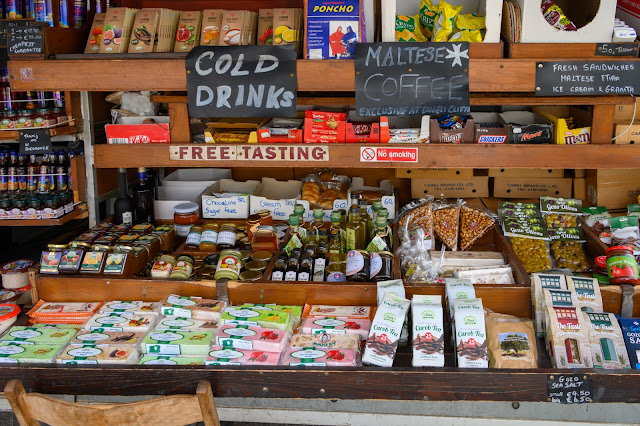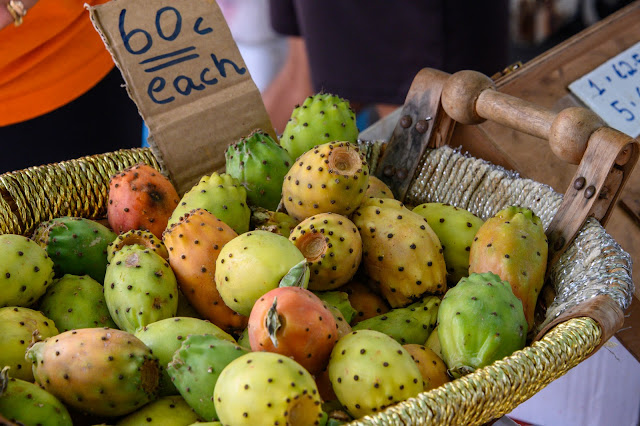Step backwards into 1964 and now you have the smallest independent country in the world, Malta.
Malta, or the Republic of Malta, is an archipelago ocated in the cental Mediterranean Sea. It consists of three inhabited islands: Malta, Gozo, and Comino.
"A small but strategically important group of islands, the archipelago has through its long and turbulent history played a vital role in the struggles of a succession of powers for domination of the Mediterranean and in the interplay between emerging Europe and the older cultures of Africa and the Middle East. As a result, Maltese society has been molded by centuries of foreign rule by various powers, including the Phoenicians, Romans, Greeks, Arabs, Normans, Sicilians, Swabians, Aragonese, Hospitallers, French, and British."
"The island of Malta specifically played a vital strategic role in World War II as a base for the Allied Powers. It was heavily bombarded by German and Italian aircraft, and by the end of the war Malta was devastated. In 1942 the island of Malta was presented with the George Cross, a British award for great gallantry, in recognition of the wartime bravery of the Maltese people. After the war, the movement for self-governance became stronger. The country of Malta became independent from Britain and joined the Commonwealth in 1964 and was declared a republic on December 13, 1974."
Fast forward to 2023 and Malta has become one of the largest tourist attractions for mainly EU residents. Approximately 84% of the inbound tourists originate from the UK, Italy, and Germany.
"The elements which make Malta so popular with tourists lie on the fact that it is the home to some of the worlds oldest temples, such as Imnajdra and Ggantija. Not to mentionthe old capital medieval city of Mdina or the capital itself, Valletta with fortifications so grand and unique. The Maltese Knights of St John are also part of an important era and famous worldwide. Malta was the country that was most bombed during the World wars (in relation to its size) mostly because of its strategic location in the middle of the Mediterranean sea."
There are also two other elments that make Malta very attractive to tourist.
The first is no secret among divers and snorklers. Malta's crystal sea water is a huge attraction for those who enjoy the sport.
"The second atrraction, created in more recent years is medical tourism. Malta Tourism Authority has been marketing Malta as a destination. Focus areas for medical tourism include "cosmetic surgery, orthopedics, ophthalmic, neurological, urological, oncology, diagnostic, bariatric and cardiac services. The focus target market for medical tourists in Malta is the United Kingdom, followed by North Africa, the Middle East, Russia and North America. Part of the reason for targeting the United Kingdom for medical tourists is that many members of Malta's medical profession were trained in the United Kingdom, increasing the confidence of British patients in those taking care of them."
But neither of these attractions are what brought us to Malta. For us it was more like curiosity.
What does the smallest independent country in the world look like?
Of course, the fact that this was one of the stopping ports on our cruise, had something to do with our curiosity.
Based on our need to satify our curiosity, we booked a half day, small group excursion. Basically, a riding trip around this small country, with all the main attractions being pointed out to us by a guide.
Therefore, most of the photos were taken through a window. Consequently, glare was my enemy as was camera shake.
Ok this first photo has no camera shake because we are standing still waiting for the transport to pick us up.
In Malta, contrast to the previous stop....ships don't need to be tendered. Instead, they can dock at the Valletta cruise port.
Needless to say, while we waited...I clicked.
And then ...off we went.
First destination/ stop was a little fishing village on the SE region of Malta, but naturally while traveling to the destination, we passed many historical buildings.
"Six megalithic temples are spread across the island of Malta, built by Neolithic inhabitants some six thousand years ago. Built from large limestone blocks, the architecture of these sites are entirely unique to this part of the world, with five of them being classified as UNESCO World Heritage Sites."
Dome and spires of the church of St. Philip Neri
The building below is the Collegiate Church of Our Lady Immaculate Conception. The original parish church stood on the location of the present church. It was built before the Great Siege of Malta of 1565It became a parish in 1586. Because of the growing number of parishioners it was decided to enlarge the church. But by 1684 the church became too small thus the construction of the present church commenced.
The designs of the church are attributed to Vincenzo Casanova while those of the bell towers are attributed to Lorenzo Gafà.The church was finished around 1730. In 1822 the church was elevated to the status of a collegiate church.

Maltese balconies, the ones you see below, dot the cities and villages of the country. We refer to them as Maltese balconies in English, but in Maltese, they are called gallarija, which translates as "gallery". The origins of the design are most likely from North Africa. The Muxarabiji is a feature of some Arabic houses in North Africa, essentially it is a window that allows the person inside the house to look out onto the street without being seen.

"As Malta’s population grew, especially in Valletta, people found they were running out of space. Enclosing the balconies and darkening the windows meant this room could be used as part of the house. In many of these places, this meant it became a bathroom (though not usually with running water or plumbing). The decoration of the balconies extends beyond the wooden colored boxes.The stone supports of the balconies, called saljaturi, can have many different designs, some of which can get to be quite elaborate. In Valletta, the corners of buildings were required to be decorated by law.This means that buildings are either decorated with statues or have windows that wrap around the corners of the buildings."
"The Hompesch Gate is a commemorative arch in Żabbar, Malta. It was built to commemorate the event when the 71st and last Grand Master of the Order Ferdinand von Hompesch zu Bolheim declared Żabbar a city – Città Gratiosae Hompesch. Hompesch visited Żabbar in 1797 and it was only after the French were expelled that the arch was built. However, any reference to the Grand Master within the design of the arch was avoided purposely since the political context was too sensitive.A religious motif has been inserted within this plain central panel. The lower part of the gate is also characterised by a number of Doric pilasters."


Marsaxlokkis a small, traditional fishing village in the South Eastern region of Malta is know for its view, fishermen, and history. Marsaxlokkis is one of the oldest seafaring settlements in the country – the Phoenicians first landed here in the 9th century BC. During the great siege Turkish fleet used this village as an anchorage. The name Marsaxlokkis comes from the Arabic word marsa, which means port and xlokk, which is the Maltese word for south-east.
The traditional Maltese fishing boat is called luzzu.This type of boat developed in the early 20th century, are usually painted in bright colours, while the bow has a pair of eyes. The design of the luzzu is believed to have evolved from the Italian gozzo which visited Malta frequently in the 1880s.
Sundays in Marsaxlokk are very busy days because Marsaxlokk fish market is known throughout the islands to be the finest in Malta. While the fish market is a daily event for restauranteur and bulk buyers, Sundays are special, as it’s the only day the public gets a whiff of the day’s catch.
Fortunately, we were not there on a Sunday and did not have to battle with the public. Instead we pretty much had the entire village to ourselves enabeling us to walk around and enjoy the scenery as well as the market.
Like many of the towns on this ancient archipelago, the scruffy, grungy, brickwork is part of its charm, accented perfectly by vibrant window shutters and wooden doors. There’s even a bright red British phone box, remanents of Britain's occupancy.
Below is a partial photo of the Villa San Souci built by Prof. Salvatore Luigi Pisani as his residence in the 1870’s. There is quite a bit of history attached to this building. For those of you who enjoy these types of historical articles here's the link.
"The first radar station in the Maltese Islands, the Dingli Radar, was established at Dingli Cliffs on March 27, 1939. Its function was to find nearby airplanes. The British also constructed and made use of an underground complex during World War II. The system established a triangulation network that connected Dingli Cliffs to Tas-Silg and Wardija, and it sent the data it had collected there for additional analysis to the Lascaris War Rooms in Valletta. The plotters used the intelligence to mark the locations of enemy aircraft on a map so that RAF fighters could intercept them.The British also installed a radio telegraphy cabin among other things. When the Maltese took over control of the air traffic systems from the British forces in 1979, the development of today's radar installation began in the 1980s."
Saint Mary Magdalene Chapel, a Roman Catholic chapel in the limits of Dingli, Malta, dedicated to Mary Magdalene. It overlooks the Dingli Cliffs, and is therefore commonly known as il-kappella tal-irdum (chapel of the cliffs). The chapel was built in 1646 on the site of an earlier one which had existed since at least the 15th century. Its simple architecture is typical of Maltese wayside chapels.
Below the chapel,parked by the roadside, was a vendor selling all sorts of stuff as you can tell by the photos. One of the items he was selling was 'prickly fruit'/ 'prickly pear' also know as cactus fruit. I had never had one before and didn't even know they were edible. If you come across them I do suggest trying....well worth it.

The Mdina Gate stands as a grand entrance to the ancient fortified city of Mdina, connecting it to the newer suburb of Rabat. Designed by de Mondion, a renowned builder for the Order of St. John, the Mdina Gate was constructed a few meters to the left of the original gate in 1724. The remains of the original gate are still visible, integrated into the now solid walls that surround the entrance.
Mdina is an architectural landmark on the island dating back almost 4,000 years. It sits behind high walls with narrow pedestrianised streets winding throughout. It was once the home of noble families, with many descendants still living in the city, with the houses being passed down through generations.
The name "Mdina" derives from the Arabic word medina, which means "the Enlightened City." Also known in Italian as "the Old City" (Città Vecchia) and "the Notable City" (Città Notabile), this fortified city once served as the capital of Malta, throughout the Middle Ages, until the arrival of the Order of St John in 1530, when the capital moved to Valletta.
Mdina displays an unusual mix of Norman and Baroque architecture, including several palaces, such as Saint Sofia Palace, most of which serve as private homes.
Mdina, is also known as the 'Silent City' because except for the few that still live in the city, there are no cars allowed.
For those of you who were fans of the series called Game of Thrones , Mdina should be very familiar. Mdina was the filming location for the series’ fictional capital city of King’s Landing in the series’ first season.
The Sanctuary Basilica of the Assumption of Our Lady commonly known as the Rotunda of Mosta or the Mosta Dome, is one of the most famous buildings in the country. This Roman catholic church was built in the late 1800’s, and aside from its beautiful design and size, it’s also famous for it’s World War II miracle. During an early mass in 1942, a Nazi aircraft dropped two bombs on the cathedral. One bounced off the dome while the other pierced it and fell into the crowd but failed to explode.
Portes des Bombes, originally called Porta dei Cannoni, is an ornamental arched gate in Floriana, Malta. It was originally built in 1721 as an advanced gate within the faussebraye of the Floriana Lines, and it was enlarged with the construction of a second archway in 1868.
The advantage of sitting up high; you can see over walls.
"St. Elmo's Light house located in the harbour entrance (exit) was built simultaneously with the breakwater to the grand harbour in Valetta. The Harbour has been used since Roman times and was used by the British as a major naval base from 1812 to the 1970s. However, protection from strong northerly winds and enemy attacks and an increased anchorage in the harbour meant that a breakwater was built from 1903 to 1908. The first stone was laid by King Edward in 1903. The lighthouse was built at the end of the breakwater to signal to ships where the end of the breakwater was located, which is 378m in length. A subway was built inside the breakwater to the lighthouse to ensure access in all weather conditions. A footbridge was installed in 2012 to the breakwater and lighthouse following the destruction of the previous footbridge during WWII."
And now to conclude this post, some general knowledge facts:
- Malta has a population density of 1,346 per km² making it the 4th most populated country in Europe and 8th in the world.
- It has two official languages: Maltese and English. Maltese language is a combination of Arabic, Italian, French and English.
- Malta doesn’t have rivers, lakes or reservoirs so they filter their drinking water from the ocean. It’s perfectly safe to drink, but you might notice a different taste.
- There are 365 churches across the country, so you could basically visit a different church every day for a year.
- Valletta was the first ever planned city in Europe. It was designed by the Knights of St John during their reign in Malta.
- Malta was awarded the George Cross by King George VI of England for its bravery during the Axis Siege in the Second World War.
- In Malta people drive on the left side of the road, which is one of the many legacies of the former British rule that you’ll notice.
(source)
(source)
(source)
(source)
(source)


















































































































Never been to Malta. Read a few stories on wartime stuff but not visited so thanks for the interesting journey you have shared. Great pictures.
ReplyDeleteIf it hadn't been for the cruise ship stopping there, we would have never chosen to put it on out list of places to visit. But I so glad we ended up. Really interesting country and so much history to be seen.
Delete